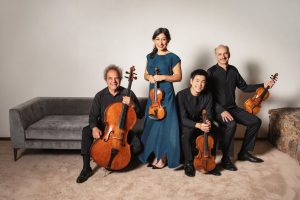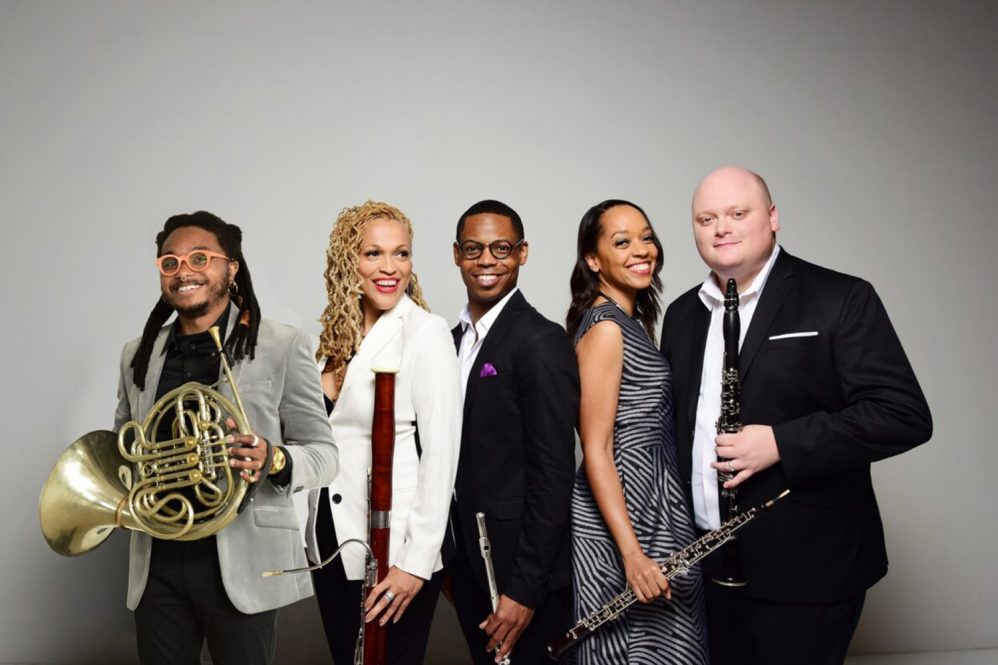The Jorgensen Center for the Performing Arts might not be as intimate as someone’s living room, but the transformation of its 2,300-seat auditorium for performances in the Lenard Chamber Music Series still allows for a personal experience – even with children seated nearby.
After all, that’s the goal of the five-year-old music series that came to UConn thanks to a donation from benefactors John and Jean Lenard: to allow adults to celebrate a music genre that requires the precision and skill of a surgeon and develop youngsters’ appreciation for the reticent beauty of the art form.
“Some students have told me after a concert it was one of the most beautiful things they’d ever heard, and those are the students you try to encourage to come back again and again,” Rodney Rock, Jorgensen director, says.

Since its outset, the Lenard Series has welcomed area K-12 students with free tickets and encouraged UConn students to take advantage of the free ticket policy for Huskies. This year, though, Rock says, Jorgensen is offering free tickets for the Lenard Series also to college students outside UConn.
It’s an effort both to grow Jorgensen’s audience and expose young adults to the music of trios, quartets, and quintets as their musical tastes are developing.
“There are folks who love classical and orchestral music, but not chamber music. Then there are people who love chamber music, but don’t like orchestral music,” Rock says. “I don’t know anyone who loves all types of music.”
Chamber music, he explains, is performed by a small group of musicians, like a string quartet, for instance, or a woodwind trio. Contrary to the sound of a large orchestra, the talent and skill of individual musicians in a chamber ensemble is on full display.
Audience members can track the notes of the clarinetist the whole way through or hear the pluck from the singular violinist.
“These are some of the best musicians out there. It’s one thing to play in the safety of a 60- or 90-piece orchestra on stage. It’s another thing to be in a trio, quartet, or even a quintet. You’re pretty exposed, and if you mess up it’s going to be obvious,” Rock says.
Since it’s a small group of musicians, an intimate setting is preferred, Rock says, such as the more formal parlors or sitting rooms of long ago or the comfortable living rooms of today.
“Most people think of chamber music as pieces written during the classical and romantic periods, but there’s lots of chamber music still being written today,” Rock explains.
And Jorgensen is where chamber musicians are eager to play.
Rock says word of the Lenard Series and Jorgensen’s commitment to the genre has traveled far, prompting booking agents to regularly call him pushing to get their ensembles on the main stage.
But it’s not the same proscenium stage used by most groups visiting Jorgensen. Rock says that for the Lenard Series, the seats in the front half of the floor are removed and a portable thrust stage is constructed to bring musicians closer to the audience.
With mezzanine lights turned off, what transformed into a 1,500-seat audience feels more like a venue a third the size, Rock says, giving the illusion of intimacy.
During the pandemic, Jorgensen did not use this setup to give audience goers enough room to spread out and, simply, feel comfortable attending performances again. With that in the past, the chamber setting has returned.
Still, Rock adds, with 1,500 seats, there’s plenty of room to stay distanced.
“In general, chamber audiences tend to be smaller anyway. An audience of 400 to 500 people is very good, and that’s what we have generally. Last fall, we presented the Emerson String Quartet on their final tour, and we had 700 people for that concert. That was extraordinary,” Rock says.
Spring 2024 in the Lenard Series starts with Imani Winds, a wind quintet, on Feb. 6 and moves to The King’s Singers, an a cappella group, on Feb. 22. Next comes Mnozil Brass, known as the Monty Python of the music world, on Feb. 28 and Takács Quartet, a string ensemble, on March 19. Bennewitz Quartet, a Czech ensemble, on April 3 and Ray Chen, a violinist, on April 16 round out the series.

Rock says the Lenards – Jean, a former UConn professor of molecular and cell biology, and John, a 1961 UConn alum – like to see a variety of ensembles on the program, not just wind or string groups, for instance.
“That’s what this spring semester speaks to,” Rock says.
Variety is what Rock says he hopes the new Huskies in his FYE class get when they learn about the arts, Jorgensen, and its offerings. These are students who may never have attended an arts performance, let alone heard chamber music.
“It’s an opportunity to grab these incoming freshmen right at the start, educate them about audience etiquette, and expose them to different types of art forms, whether dance or music,” Rock says of the class. “I tell them if they don’t like it, that’s fine, just tell me why. Most, though, give the experience a chance and most students are really impressed.”
Tickets to Jorgensen’s performances, including the Lenard Chamber Music Series, can be obtained online. UConn students seeking tickets to a performance in the Lenard Chamber Music Series should log into the Jorgensen’s site using their NetID. All other K-12 and college students – and UConn students seeking free rush tickets to other Jorgensen shows – should email the box office, jorgensen.tickets@uconn.edu.



